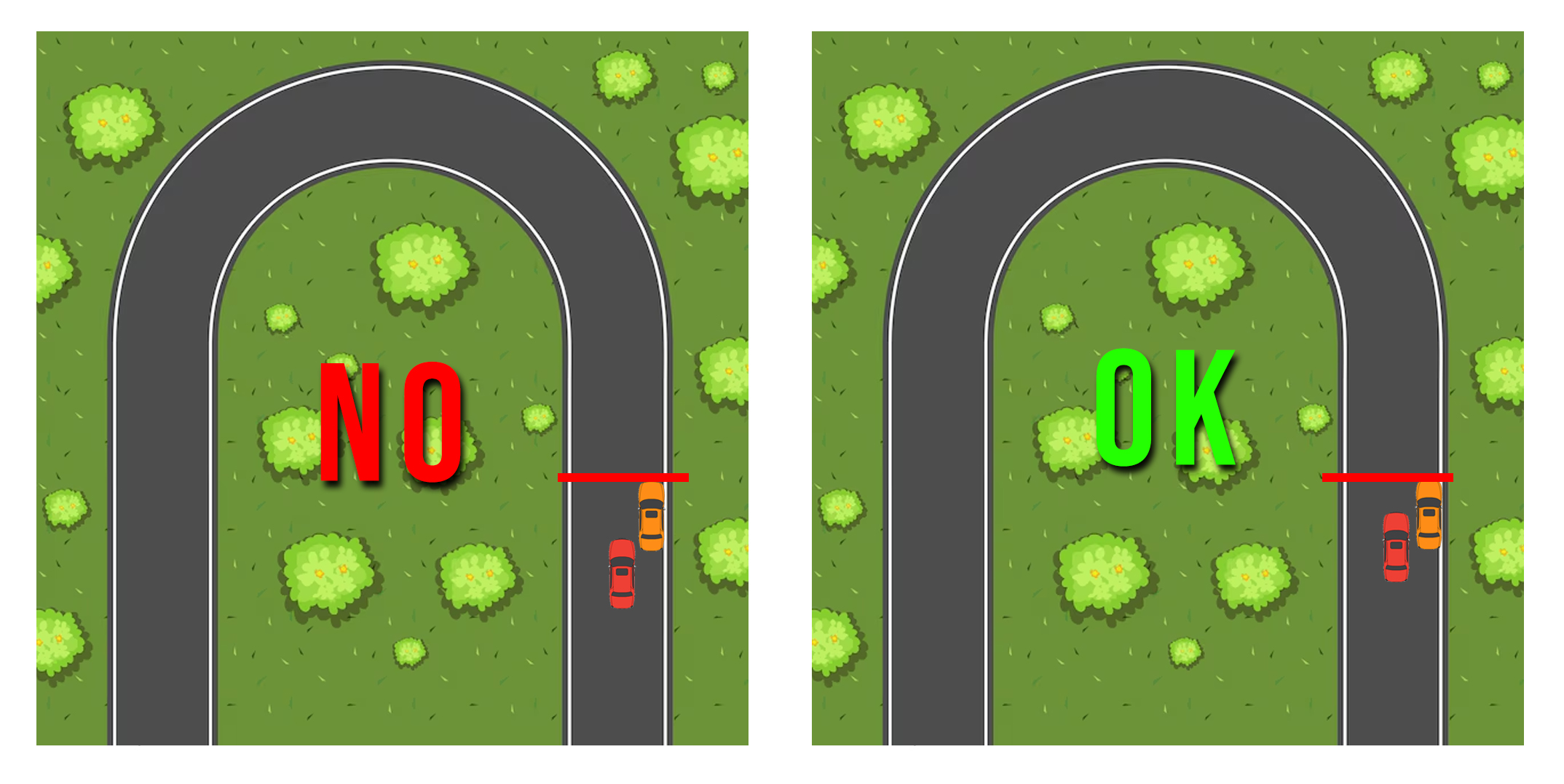
PROGETTO G REWARDS FAIR-PLAY AND PUNISHES (SEVERELY), RECKLESS DRIVING (DIVE BOMBING).
OVERTAKES - PLEASE READ!!!!
Competitors can defend their position, but without the way for the cars attacking them, which means that you cannot go out of line more than once per straight track. You can change the trajectory, but only once. Doing this more than once in a single straight stretch is considered to "cut the road", which will result in a penalty.
50% RULE
The attacking car has the right to the car in front of it, only when it is placed to put the front bumper over the side before the door, that is, when it is more than half length beside the car you intend to overtake. So, watch out for "ram" style entrances, because the penalty will be triggered, in case of contact, unless you get overtaken by the car incorrectly overtaken. Racing-Room-Passing-Guidelines-attributed EN If those who overtake irregularly cause a loss of control in the opposing car (overtaken), such as going off the road, the car that caused the irregularity will be penalized with 30 seconds at the end of the race, with a Drive Through, with a Stop & Go or with a disqualification, depending on the severity of the irregularity and the damage caused. An irregular overtaking, according to the one explained above, will not be punished if the overtaken car does not lose significant time in the race and if the competitor who has committed the incorrectness is overtaken by the incorrectly overtaken car.

FLASHING
Flashing repeatedly, in order to annoy the competitor in front, is considered incorrect. We will take measures, applying more or less severe penalties, according to the situations. Who is this victim of the type of "bullying on the track", can also expose what happened after the race. The penalties will be applied to the race itself, or to subsequent races, whether these are of the 4fun or championship type.
CHAT
It is forbidden to use the chat during free practice, qualifying and race sessions. For messages to competitors, the Discord channel can be used, which displays messages in the top left when the user enables overlay mode.
In general, the rules to be followed in 4fun races and in the championships we organize are those of Blancpain and SRO, the two organizations that regulate the races of the GT3 championship.
But we want to clarify the regulation on blue flags.
There is a mischief in the general world of ACC that needs to be cleared up: Blue flag in GTs doesn't mean you MUST let the car pass behind you, you come in F1. It's just information for you. The etiquette says that if the car behind you is faster you have to keep your pace but don't make defensive moves when the car is passing you.
BLUE FLAGS
https://www.gt-world-challenge-europe.com/images/news/2018/S02_Blancpain_GT_Series_2018_Sporting_Regulations_LR.pdf
Unlike Formula 1 races, the blue flags in GT3 races are informative and not representative. In GT3 reasons are used to INFORM the driver, for safety, that there is a faster car coming, they are not an instruction to let the opponent pass behind.
In Formula 1, the driver is forced to slow down to let the opponent pass behind him, and if he does not do so within 3 corners, he is penalized. This is not the case with GT3 and, therefore, not with ACC either.
If you look at the real races, in each of them the lapped cars will be among the others and will rarely give positions. Leaders often waste a lot of time lapping cars.
Conclusion on the topic BLUE FLAGS:
The dubbed competitor has the right to make his race, that is to make up the lost positions, which means that he has the right to overtake the competitors who have lapped him, to split.
The dubbed has no obligations, but a moral duty, which is to let the arriving competitor pass, so as not to prevent him from making his race, not to act as a stopper, when he is much faster. We repeat ... it is a moral duty, not an obligation, so any complaint that will have as its subject a complaint about a dubbed competitor who has been shown the blue flag, will simply be ignored.
---------------------------------------------------------------------------------------------------------------------------------
PROGETTO G PREMIA IL FAIR-PLAY E PUNISCE, ANCHE SEVERAMENTE, LA GUIDA INCOSCIENTE (DIVE BOMBING).
SORPASSI
I concorrenti possono difendere la propria posizione, ma senza tagliare la strada alle auto che le attaccano, il che significa che non si può uscire di traiettoria per più di una volta per tratto di pista dritto. Si può cambiare traiettoria, ma una sola volta. Farlo più di una volta in un singolo tratto rettilineo, è considerato "tagliare la strada", il che risulterà in una penalità.
Regola del 50% - L'auto che attacca ha diritto di spazio solo se ha metà auto affiancata all'auto attaccata per almeno il 50% della lunghezza, cioè solo quando è riuscita a mettere il paraurti anteriore oltre la fiancata prima dello sportello, al punto di frenata. Quindi, attenzione alle entrate in stile "ariete", perché scatterà la penalità, in caso di contatto, a meno che non ci si faccia sorpassare dall'auto soprassata scorrettamente.

LEGGI QUESTO >> Racing-Room-Passing-Guidelines-attributed ITA
Se chi sorpassa irregolarmente causa una perdita di controllo nell'auto avversaria (sorpassata), tipo un'uscita di strada, l'auto che ha causato l'irregolarità verrà penalizzata con 30 secondi a fine gara, con un Drive Through, con uno Stop&Go o con una squalifica, a seconda della gravità dell'irregolarità e del danno causato. Un sorpasso irregolare, secondo quello spiegato sopra, non verrà punito, se l'auto sorpassata non perde tempo significativo alla gara e se il concorrente che ha commesso la scorrettezza si fa sorpassare dall'auto soprassata scorrettamente.
USO DEGLI ABBAGLIANTI
L'uso degli abbaglianti in modo ripetuto, al fine di infastidire il concorrente che precede, è considerato scorretto. Prenderemo provvedimenti, applicando penalità più o meno severe, in base alle situazioni. Chi è vittima di questo tipo di "bullismo in pista", può esporre l'accaduto, anche dopo la gara. Le penalità verranno applicate alla gara stessa, oppure alle gare successive, sia queste siano di tipo 4fun o di campionato.
CHAT
E' vietato l'uso della chat durante le sessioni di qualifiche e gara. Per i messaggi ai concorrenti, si può usare il canale Discord, che mostra i messaggi in alto a sinistra quando l'utente abilità la modalità overlay (sovra imposizione).
In generale, le regole a cui attenersi nelle gare 4fun e nei campionati da noi organizzati, sono quelle della Blancpain e SRO, le due organizzazioni che regolamentano le gare del campionato GT3.
Ma ci teniamo a chiarire il regolamento sulle bandiere blu.
BANDIERE BLU'
C'è un malinteso generale nel mondo di ACC che deve essere chiarito: Bandiera blu nelle GT non significa che DEVI far passare l'auto dietro di te, come in F1. È solo un'informazione per te. L'etichetta dice che se l'auto dietro di te è più veloce devi mantenere il tuo ritmo ma non fare mosse difensive quando l'auto ti sta facendo un passaggio.
https://www.gt-world-challenge-europe.com/images/news/2018/S02_Blancpain_GT_Series_2018_Sporting_Regulations_LR.pdf
Differentemente dalle gare di Formula 1, le bandiere blu nelle gare di GT3 sono informative e non impositive, cioè non rappresentano obblighi. Nel GT3 sono utilizzate per INFORMARE il pilota, per ragioni di sicurezza, che c'è una macchina più veloce che sopraggiunge, non sono un'istruzione a lasciar passare l'avversario dietro.
In Formula 1, il pilota è obbligato a rallentare per far passare l'avversario dietro di lui, e se non lo fa entro 3 curve, viene penalizzato. Non è il caso di GT3 e, quindi, nemmeno di ACC.
Se guardi le gare reali, in ognuna di esse le auto doppiate saranno tra le altre e raramente daranno posizioni. I leader spesso perdono molto tempo a doppiare le auto.
Conclusione sull'argomento BANDIERE BLU':
Il concorrente doppiato ha diritto a farsi la sua gara, cioè a rimontare le posizioni perse, il che significa che ha il diritto di sorpassare i concorrenti che lo hanno doppiato, per sdoppiarsi.
Il doppiato non ha obblighi, ma dovere morale, che è quello di far passare il concorrente che sopraggiunge, per non impedirgli di fare la sua gara, per non fare da tappo, quando questo è nettamente più veloce. Ripetiamo... è un dovere morale, non un obbligo, quindi ogni reclamo che avrà come oggetto una lamentela su un concorrente doppiato a cui è stato mostrato la bandiera blu, verrà semplicemente ignorato.









